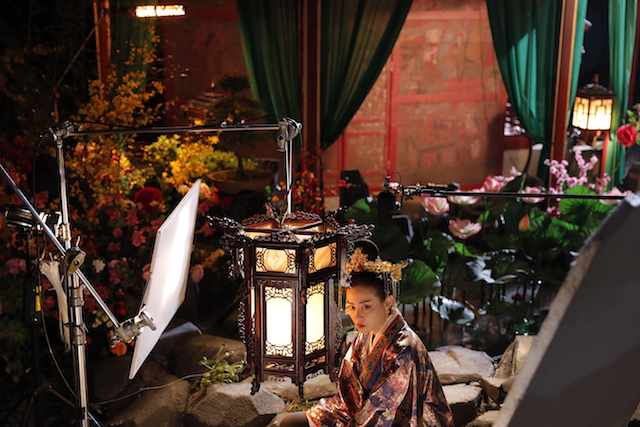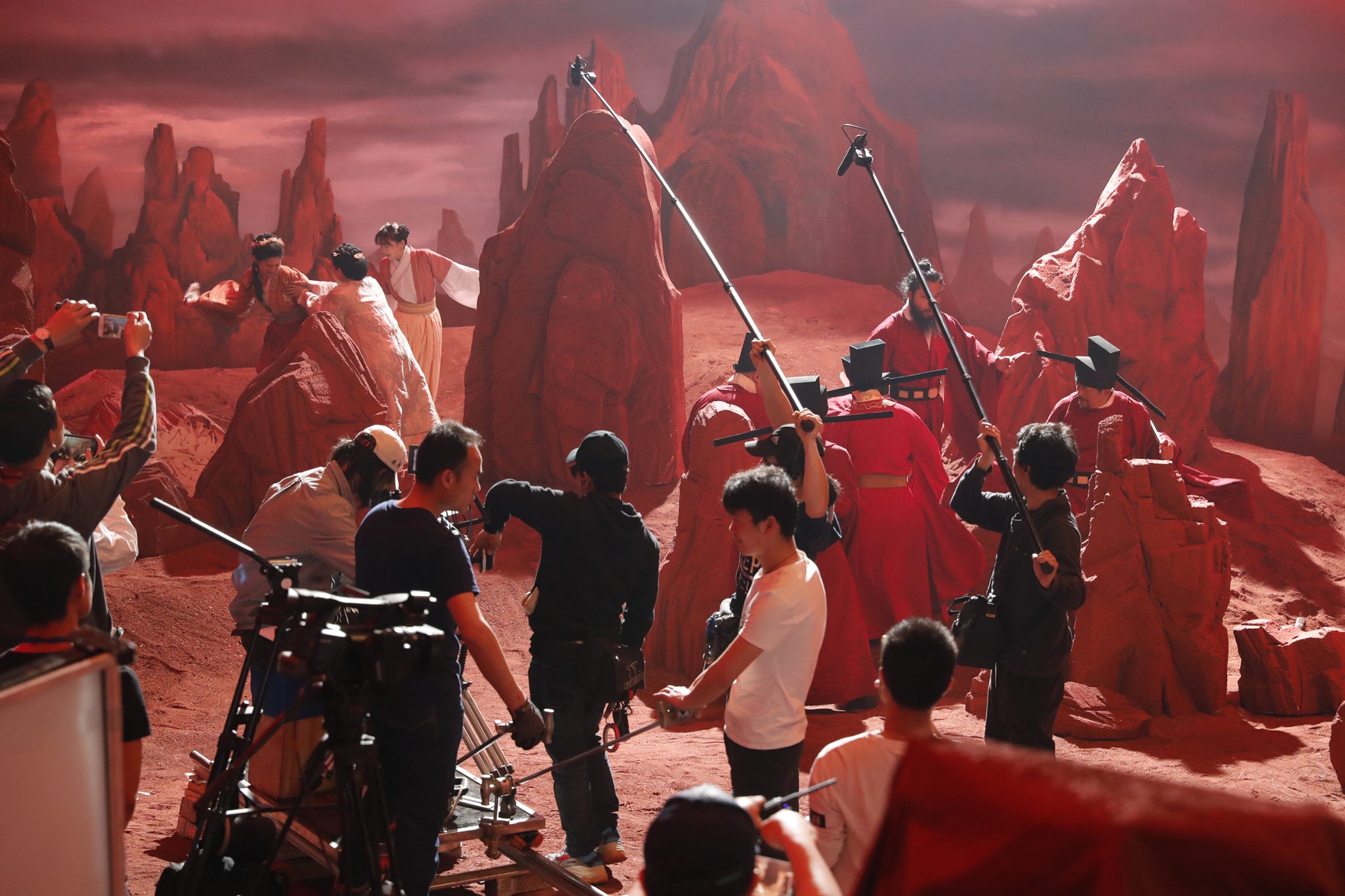With the opening of Yang Fudong’s latest solo exhibition, now on view at Shanghart’s West Bund outpost (8 November – 24 January, continuing his ongoing exploration of the concept of ‘Huihua dianying’ – ‘Painting as a film’), ArtReview Asia looks back at last year’s interview with the filmmaker and artist
In March 2018 Yang Fudong, arguably China’s leading video artist, exhibited the first stage of a new project at Shanghai’s Long Museum West Bund. Dawn Breaking marked the realisation of a longstanding ambition to make the shooting of a work a live performance. Accordingly, Yang constructed two largescale sets within the museum and filmed on them, in front of an audience, over the course of a month. The action surrounds the ceremonial and artistic life (for example, the morning ceremony at which the emperor would discuss matters of state with his ministers) during the Song Dynasty period in Chinese history (960–1279 CE). At the end of each day the artist presented an edited short film of the day’s work as a form of video diary, each one marking an evolution towards a final film that is yet to come. The diaries themselves featured the day’s filming, interspersed with quotations from the works of Friedrich Nietzsche, which provided a form of psychological commentary on the scenes that had been shot and connected the past to the present. The journey towards a final film is intended to take place via several exhibitions and countries. The first stop post-Shanghai is at Marian Goodman Gallery, London.
ArtReview Asia The title of your new exhibition takes Friedrich Nietzsche’s Beyond Good and Evil [1886] and adapts it to Beyond GOD and Evil. Why God?
Yang Fudong In the Chinese version of the title, ‘good’ was translated as shàn, which has a much wider meaning. When we translated the title back into English I thought we could play with the words a little bit, to address the religious overtones and wider meaning of shàn in Chinese.
ARA How did the interest in Nietzsche develop?
YF This exhibition is the second part of a film project that began at the Long Museum West Bund in Shanghai in 2018, part of my ongoing Museum Film Project. The film project is called Dawn Breaking in English, and it’s an account of life during the Song Dynasty, inspired by – among other things – the writings of Nietzsche, whose language and thinking offered a structure for the film.
ARA What is the relationship of Western philosophy to Chinese history, do you think? I say this in part because in so many parts of Asia the twentieth century was marked by both an embrace of Western thinking as a sign of modernity and a rejection of it as a mark of colonialism.
YF I think Chinese people tend to have a good understanding of their traditional culture, and to understand the country’s history through its many religions or philosophies, including Taoism, Confucianism or Buddhism. But I think they have realised that there are different ways of thinking in the world – including Western philosophies – and that they are not independent, they are complementary. Chinese philosophies have also been spreading around the world.
ARA Yes, and I guess there’s a particular relationship between Nietzsche and Buddhism, particularly in the notion of return and reincarnation that’s sometimes in conflict and sometimes sympathetic.
YF They inform each other.
ARA Dawn Breaking and Beyond GOD and Evil also reveal the structure of the film in the process of its making, which is different from other works you’ve made. It is a bit like a magician showing his audience how the trick works: even though we’re not watching you shoot in the Long Museum, here we see footage of actors in harnesses that allow them to fly through the air, we see the edges of sets and the boom mics.
YF There is a difference between the diary works or ‘dailies’ and the ‘final work’. The 36 dailies exhibited downstairs at Marian Goodman [as a single installation] record what was happening onsite [in Shanghai] every day, and so they contain mistakes, and these are presented to the audience. But these errors, of course, do not make the ‘final cut’ of the film. The viewer gets to be the director: they can see how things change onset, and then predict how the film will turn out. But the film in its final version is something different from the dailies showing the process of making it.

ARA Which version do you like best?
YF I have no preference: it’s half-and-half. It’s an ancient story and the actors wear period costumes, but the way it’s presented allows the audience to step outside of that, to see the lights, cameras and production team. I want the audience to think about how it is constructed, to question whether it is the story or the process of shooting it that is the ‘true’ thing.
ARA Do you think it’s slightly ridiculous for people to look for truth in an artist’s construction?
YF That depends. In China, we also have a proverb that says, ‘Seeing is believing.’ I’m interested in asking the audience to think about how and whether that applies.
ARA Is that analogous to the way in which audiences have to decode your installations, in many of which the work is spread across multiple screens, around which people can move in different ways and reconstruct the work according to different narratives?
YF Yes. When we were making the exhibition in Shanghai we had two different ways of showing what we were filming. One was to show the actual film on different screens and the other was to show some of the dailies as an evolving film on one larger screen. Every day after we shot, dailies would be edited into a continuous film version shown on one large screen, but we would also show the 36 dailies (one for each of the 36 days) individually on monitors, screens or as projections. In this way we showed the audience different ways of viewing a film, which I think is both artistic and varied.
ARA The last time I saw one of your earlier video installations, Revival of the Snake [2005], each of the people watching would decide that one of the ten screens in the installation was the start of the video, and often it wasn’t the first one you came to in the space. In London, some of the dailies are shown on monitors or flat screens, while others are projected onto a patterned wallpaper fabric that gives them something of the feel of paintings.
YF The wallpaper is an important element: the film is set during the Song Dynasty, so we chose traditional Chinese patterns that would evoke the era.

ARA You chose the Song Dynasty because it marked something of a renaissance in the arts?
YFThe Song Dynasty was a very prosperous time, and a highpoint in Chinese culture. Yet, as in any other time, there were conflicts and difficulties.
ARA Including debates about the relationship to God, and specifically the influence of Buddhism.
YF It’s not necessarily that Buddhism came into the wider society and created conflict. In every society, as Nietzsche’s book makes clear, there are conflicts of desire and struggles for power among the people. I think this is humanity.
ARA So, do you think these motivations are eternally present?
YF History always repeats itself.
ARA Modern China has a complicated relationship with its own history, marked, not least, by the Cultural Revolution [1966–76]. But even today, it seems to me, many artists, even younger ones, seem reluctant to associate themselves with the past.
YF In every era and country there are artists who prefer to focus on everyday life, while there are also those who would consider history on the national and global scale while trying to express themselves creatively. I think that contemporary art is grounded in history; it is not a standalone project.
ARA That’s not always acknowledged.
YF Perhaps contemporary art might not show its historic elements on the surface, but it’s impossible to separate it completely from the history of a community. When I was teaching at university, I would always introduce my students to early Chinese art.
ARA The texts that you supply about your works, in exhibition handouts, for example, tend to avoid direct interpretation, or to skirt the idea that there is fixed meaning behind them. Is that important?
YF Yes, because I think everybody will have their own interpretation shaped by their own experiences and cultural background. I don’t want to define the artwork. It’s up to the artist to decide how much information he wants to give to the audience. But if he decides not to explain the work, he also needs to make sure that the viewer has enough information to be able to make their own interpretation. Talking about this exhibition, I would like the audience to know a little background: that it relates to last year’s film project in Shanghai, that this is an ongoing project and so the film may change in the future and new scenes perhaps be added, and that the intention was to show the process of making a film.
Beyond GOD and Evil – Preface was on show at Marian Goodman Gallery, London, through 26 July 2019
From the Summer 2019 issue of ArtReview Asia
